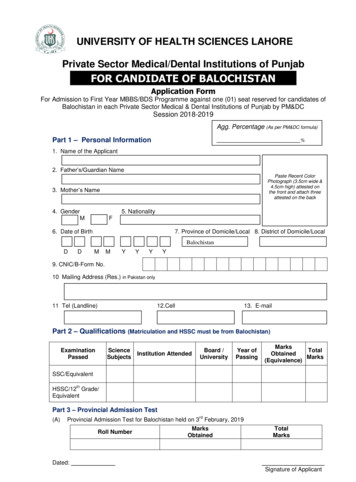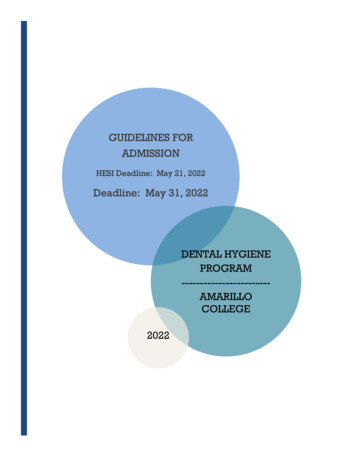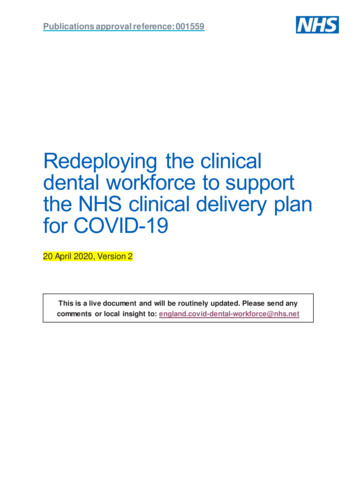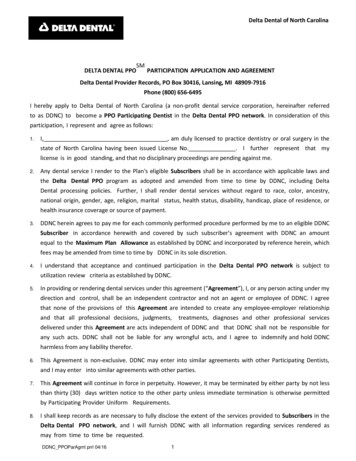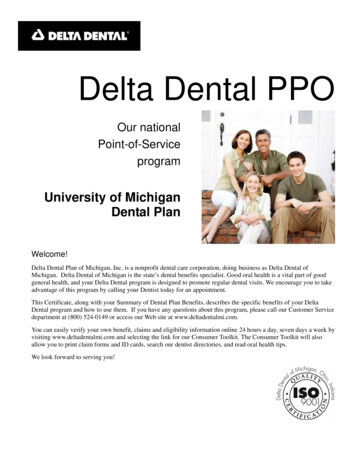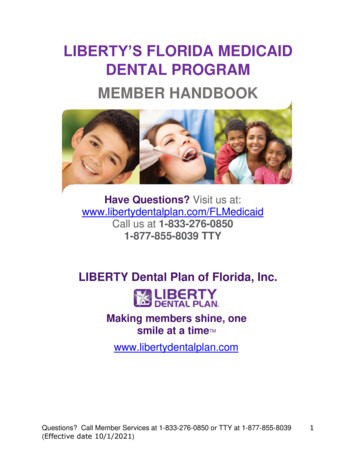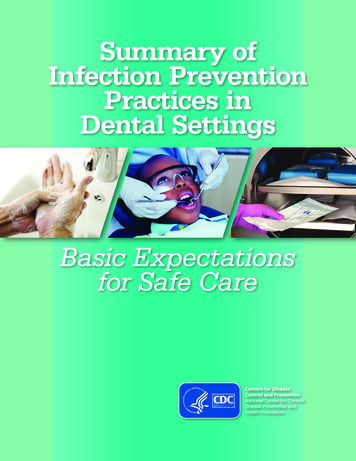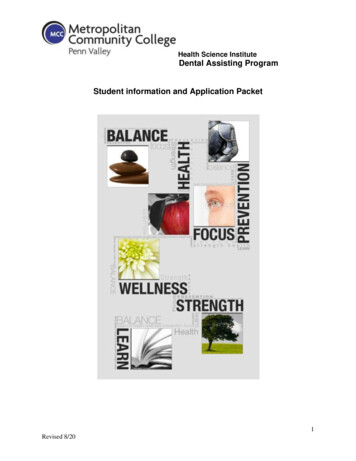
Transcription
11th editionTextbook forDental NursesIn this brand-new 11th edition of the original, best-selling book, Levison’s gives you the same greatcomprehensive coverage of everything students preparing for their dental nurse qualification need toknow, and also offers for the first time: A new look and feel, packed with illustrations and diagrams to make visual learning easy Key Learning Points in every chapter to help you master essential information An interactive companion website with self-assessment exercises to help you test your knowledgeFully in line with the most recent developments in dental nursing practice and education, Levison’sTextbook for Dental Nurses is the only dental nursing book written specifically to cater to the newNEBDN Diploma in Dental Nursing. Written by Carole Hollins, the former Chair of the National ExaminingBoard for Dental Nurses, the new edition of Levison’s classic textbook is the only companion you needto get you through to qualification as a successful and accomplished dental nurse.About the AuthorRelated titlesQuestions and Answers for Dental Nurses,3rd editionCarole HollinsISBN: 978-0-470-67090-3NVQs for Dental Nurses, 2nd editionCarole HollinsISBN: 978-1-4051-9256-9Basic Guide to Anatomy and Physiology forDental Care ProfessionalsCarole HollinsISBN: 978-0-470-65611-2Advanced Dental Nursing, 2nd editionRobert IrelandISBN: 978-1-4051-9267-5Textbook forDental Nursescarole hollinshollinsCarole Hollins is a dental practitioner and member of the British Dental Association. She is a memberof the Faculty of General Dental Practitioners and a former presiding examiner for the NEBDN. She wasa previous Chairman of both the National Certificate Committee and the Qualifications Council. CaroleHollins is the author of NVQs for Dental Nurses, Questions and Answers for Dental Nurses and BasicGuide to Dental Procedures.Levison’s11th editionVisit the companion website at: www.levisonstextbookfordentalnurses.com Interactive MCQs Interactive EMQs Glossary Lecturer image bankLevison’sTextbook for Dental NursesLevison’s11th editionHollins Levinsons 9781118500446 pb.indd 1aCQs ndE M Qs9 781118 500446w it h MISBN 978-1-118-50044-614/05/2013 11:01
Levison’s Textbookfor Dental Nurses
This book is dedicated to the memory of Henry Levison – a visionary dentist and authorwho set the standard for dental nurse training and education.
Levison’s Textbookfor Dental NursesEleventh EditionCarole HollinsGeneral Dental PractitionerMember of the British Dental AssociationFormer presiding examiner for the National Examining Board for Dental Nurses
This edition first published 2013. 2013 John Wiley & Sons, Ltd 2004, 2008 Blackwell Munksgaard 1960, 1963, 1969, 1971, 1978, 1985, 1991, 1997 Blackwell Science LtdFirst edition published 1960; Second edition published 1963; Third edition published 1969; Fourth edition published 1971; Fifth editionpublished 1978; Sixth edition published 1985; Seventh edition published 1991; Eighth edition published 1997; Ninth edition published 2004;Tenth edition published 2008; Eleventh edition published 2013.Registered OfficeJohn Wiley & Sons, Ltd, The Atrium, Southern Gate, Chichester, West Sussex, PO19 8SQ, UKEditorial Offices9600 Garsington Road, Oxford, OX4 2DQ, UKThe Atrium, Southern Gate, Chichester, West Sussex, PO19 8SQ, UK2121 State Avenue, Ames, Iowa 50014-8300, USAFor details of our global editorial offices, for customer services and for information about how to apply for permission to reuse the copyrightmaterial in this book please see our website at www.wiley.com/wiley-blackwell.The right of the author to be identified as the author of this work has been asserted in accordance with the UK Copyright, Designs and PatentsAct 1988.All rights reserved. No part of this publication may be reproduced, stored in a retrieval system, or transmitted, in any form or by any means,electronic, mechanical, photocopying, recording or otherwise, except as permitted by the UK Copyright, Designs and Patents Act 1988,without the prior permission of the publisher.Designations used by companies to distinguish their products are often claimed as trademarks. All brand names and product names used inthis book are trade names, service marks, trademarks or registered trademarks of their respective owners. The publisher is not associated withany product or vendor mentioned in this book. It is sold on the understanding that the publisher is not engaged in rendering professionalservices. If professional advice or other expert assistance is required, the services of a competent professional should be sought.The contents of this work are intended to further general scientific research, understanding and discussion only and are not intended and shouldnot be relied upon as recommending or promoting a specific method, diagnosis or treatment by health science practitioners for any particularpatient. The publisher and the author make no representations or warranties with respect to the accuracy or completeness of the contents ofthis work and specifically disclaim all warranties, including without limitation any implied warranties of fitness for a particular purpose. In viewof ongoing research, equipment modifications, changes in governmental regulations and the constant flow of information relating to the use ofmedicines, equipment and devices, the reader is urged to review and evaluate the information provided in the package insert or instructions foreach medicine, equipment or device for, among other things, any changes in the instructions or indication of usage and for added warnings andprecautions. Readers should consult with a specialist where appropriate. The fact that an organisation or website is referred to in this work as acitation and/or a potential source of further information does not mean that the author or the publisher endorses the information the organisationor website may provide or recommendations it may make. Further, readers should be aware that internet websites listed in this work may havechanged or disappeared between when this work was written and when it is read. No warranty may be created or extended by any promotionalstatements for this work. Neither the publisher nor the author shall be liable for any damages arising herefrom.Library of Congress Cataloging-in-Publication DataHollins, Carole.Levison’s textbook for dental nurses / Carole Hollins. – 11th ed.p. ; cm.Textbook for dental nursesIncludes bibliographical references and index. ISBN 978-1-118-50044-6 (pbk. : alk. paper) – ISBN 978-1-118-50043-9 (ePub) – ISBN 978-1-118-50042-2 (Mobi) – ISBN 978-1-118-50041-5 –ISBN 978-1-118-68990-5I. Levison, H. (Henry). Textbook for dental nurses. II. Title. III. Title: Textbook for dental nurses.[DNLM: 1. Dental Assistants. 2. Dental Care. WU 90]RK60.5617.6′0233–dc232013012752A catalogue record for this book is available from the British Library.Wiley also publishes its books in a variety of electronic formats. Some content that appears in print may not be available in electronic books.Cover image: Irfan Ahmad, BDSCover design by Meaden CreativeSet in 10/12pt Calibri by SPi Publisher Services, Pondicherry, India12013
ContentsIntroduction to the Eleventh Edition Introduction to the First Edition Acknowledgements Abbreviations How to use your Textbook and Companion Website Copyright Information viviiiixxxiiixvChapter 1: Structure of the Dental Profession 1Chapter 2: The Dental Nurse 9Chapter 3: Legal and Ethical Issues 30Chapter 4: Health and Safety in the Dental Workplace 74Chapter 5: General Anatomy and Physiology 123Chapter 6: Medical Emergencies 155Chapter 7: Microbiology and Pathology 181Chapter 8: Infection Control and Cleanliness 197Chapter 9: Head and Neck Anatomy and Physiology 229Chapter 10: Oral Anatomy and Physiology 248Chapter 11: Oral Disease 274Chapter 12: Oral Health Assessment and Diagnosis 307Chapter 13: Oral Health Promotion and Disease Prevention 352Chapter 14: Pain and Anxiety Control 386Chapter 15: Restorative Dentistry 417Chapter 16: Prosthodontics 473Chapter 17: Extractions and Minor Oral Surgery 529Index 556
Introduction tothe Eleventh EditionSince the last edition was written, dental nurses have joined other members of the dentalteam to become registered professionals with the General Dental Council (GDC), and have atlast been elevated to their well-deserved status as invaluable dental care professionals.With this professional recognition comes the necessity for set standards of attitude andbehaviour outside the workplace, as well as suitable qualification, ethical work practicesand the requirement for lifelong learning and continuous professional development duringtheir careers.This edition provides the underpinning knowledge required to cover the extensive curriculumcontents of the National Examining Board for Dental Nurses’ (NEBDN) new National Diploma qualification, which supersedes the old National Certificate. You can view the full curriculum forthe NEBDN National Diploma in Dental Nursing at http://www.nebdn.org/diploma in dentalnursing.html. A similar textbook will be available to cover the City & Guilds’ curriculum for its newDiploma in Dental Nursing qualification. Although the same register-able qualification is awardedto successful candidates following either route to registration, the training and assessmentmethods involved for each are quite different.The revised and updated text of this latest edition embraces all the numerous legislative andregulatory changes that have occurred in the last 5 years, including issues around Health andSafety, infection control, information governance, quality assurance requirements and the expansion of the concept of continuous professional development into that of team membersbecoming ‘reflective practitioners’. In particular, the text in relevant chapters puts particularemphasis on the standards to be attained in becoming dental professionals, and has been continuously cross-referenced to the GDC’s own Standards Guidance booklets, as well as some ofits other publications such as Fitness to Practise, in the hope that their content is easily absorbedinto the understanding and knowledge base of the readers.In addition and where appropriate, website addresses are included to allow readers to accessfurther information on many topics covered throughout the text – especially links to the NEBDN’scurriculum and charting booklet download facilities, and links to more information on subjecttopics with national variations, such as infection control.
Introduction to the Eleventh EditionIt is hoped that the increased use of photographs and illustrations, as well as that of bulletpoints to highlight key facts throughout the text, makes this edition particularly user-friendly andeasy to understand for all readers, without detracting from the high standards now expected ofdental nurse students as they evolve into fully fledged dental professionals. Finally, and as always,I sincerely hope that this text stimulates at least some readers into becoming sufficiently inspiredduring their studies to continue their careers beyond their initial qualification, and considerextended duties, postregistration qualifications and further dental professional careers.NEBDN National Diploma in Dental NursingYou can view the full curriculum for the NEBDN National Diploma in Dental Nursing athttp://www.nebdn.org/diploma in dental nursing.html.Carole Hollinsvii
Introduction tothe First EditionThis book is designed to cover the syllabus for the British Dental Nurses and Assistants Examination.Although written primarily for nurses preparing for this examination, it also provides an outline ofdental surgery for those embarking on a career of dental nursing, thus helping them gain a greaterunderstanding of the nature and aims of their duties. For examination purposes, the subjectmatter is deliberately presented in a dogmatic fashion and, to aid final revision, there is a summaryafter each chapter.The text was prepared during a winter spent in the North Isles of Shetland with the SchoolHealth Service mobile dental unit; and for helpful advice and encouragement throughout, I amindebted to my former dental nurse, Miss M.E. Isbister. I wish to thank my wife for typing the manuscript; my sister, Miss B. Levison, for the drawings; the Amalgamated Dental Trade DistributorsLtd for providing some new blocks; and Mr P. Saugman of Blackwell Science for his guidance.H. Levison
AcknowledgementsSadly, since the last edition of this popular book was published, its original author Henry Levisonhas passed away. Therefore this edition is dedicated to his memory in grateful thanks, on behalfof the thousands of dental nurses whose careers are hopefully the better for his many years ofdedication to their educational needs.Once again, I must extend my grateful thanks to the patients and staff of Kidsgrove dental practice for their modelling skills, and give sincere thanks also to my sister (yet again!) for her technicaland computer-related wizardry – thank goodness she knows what she’s doing!In updating this edition, I am very grateful to the General Dental Council and the Department ofHealth for their permissions to reproduce various documents and booklets throughout the text,and I hope I have done justice to their content. I must also express great appreciation for thecontinued support of previous illustrators too.Finally, a huge ‘thank you’ to the various staff of Wiley Blackwell (past and present) for theirsuperb help and support throughout the updating and publishing process, and especially thespeedy professionalism with which they work.
AbbreviationsADJAEDAIDSamelodentinal junctionautomatic external defibrillatoracquired immune deficiencysyndromeALARA as low as reasonably achievableALARP as low as reasonably practicable/possibleALSAdvanced Life SupportANUG acute necrotising ulcerativegingivitisARFannual retention feeBADN British Association of Dental NursesBDABritish Dental AssociationBDJBritish Dental JournalBDSBachelor of Dental SurgeryBLSBasic Life SupportBNFBritish National FormularyBPEbasic periodontal examinationBSABusiness Services Agency (previouslyDental Practice Board)CALcomputer-aided learningC&GCity & GuildsCGclinical governanceCJDCreutzfeldt–Jakob diseaseCOAD chronic obstructive airways diseaseCOSHH Control of Substances Hazardous toHealthCPDcontinuing professionaldevelopmentCPITN Community Periodontal Index ofTreatment iopulmonary resuscitationCare Quality CommissionCriminal Records Bureaucerebrospinal fluiddental care professionalDiploma in Dental Public HealthDiploma in Dental RadiologyDiploma in General Dental Practicedecayed, missing, filleddistal occlusalDiploma in OrthodonticsDental Practitioners’ Formularydental panoramic tomographdangers, response, airway, breathing,circulationDental Reference Officerdeep vein thrombosisexpired air ventilationexternal cardiac compressionelectrocardiogramextended matching questionfull upper denturefull upper and lower denturesfull lower dentureWorld Dental FederationFellow in Dental Surgeryfull gold crowngeneral anaesthesiaGeneral Dental Councilgeneral dental practitionergold inlay
AbbreviationsGICGITGPGTNHBVHCVHIVglass ionomer cementgastrointestinal tractgutta perchaglyceryl trinitrate (spray)hepatitis B virushepatitis C virushuman immunodeficiencyvirusHRThormone replacementtherapyHSEHealth and Safety ExecutiveHTM 01-05 Health Technical Memorandum01-05IGinformation governanceIHinhalation sedation (previouslyrelative analgesia)INRinternational normalised ratioIOTNIndex of Orthodontic TreatmentNeedIPAisopropyl alcoholIR (ME) RIonising Radiation (MedicalExposures) RegulationsIRRIonising Radiation RegulationsITinformation technologyIVintravenousLAlocal anaesthesia (analgesia)LDSLicentiate in Dental SurgeryLPALaser Protection AdvisorLPSLaser Protection SupervisorLSABLocal Safeguarding Adults BoardLSCBLocal Safeguarding ChildrenBoardMAOImonoamine oxidase inhibitorMCQmultiple choice questionMFDSMember of the Faculty of DentalSurgeryMGDSMembership in General DentalSurgeryMImyocardial infarctionMIMSMonthly Index of MedicalSpecialitiesMJDFMembership of the Joint DentalFacultiesMMRmeasles, mumps and rubella(vaccination)momesial occlusalmodmesial occlusal distalMOSminor oral surgeryM Paed Dent Membership in lococcus aureusMScMaster of ScienceNEBDNNational Examining Board forDental NursesNHSNational Health ServiceNICENational Institute for Healthand Clinical ExcellenceNMEnon-milk extrinsic (sugar)NSAIDnon-steroidal antiinflammatory drugNVQNational VocationalQualificationOHAoccupational health advisorOPGdental panoramic tomograph(orthopantomograph)OSCEobjective structured clinicalexamP/partial upper dentureP/Ppartial upper and lowerdentures/Ppartial lower denturePATportable appliance testingPBCporcelain bonded crownPCTprimary care trustPDPpersonal development planPEpartially eruptedPIDAPublic Interest Disclosure Act1998PJCporcelain jacket crownPoMprescription-only medicinePPEpersonal protective equipmentppmparts per millionPVporcelain veneerQAquality assuranceRArelative analgesia (nowknown as inhalationsedation)RIDDORReporting of Injuries, Diseasesand Dangerous OccurrencesRegulationsRPARadiation Protection AdvisorRPSRadiation Protection SupervisorSCCsquamous cell carcinomaSWOT strengths, weaknesses, opportunitiesand threatsxi
AbbreviationsxiiTIATMJTTPUEtransient ischaemic attacktemporomandibular jointtender to percussionuneruptedvCJDnew-variant Creutzfeldt–JakobdiseaseWHO World Health OrganizationZOE zinc oxide and eugenol cement
How to use yourTextbook andCompanion WebsiteWelcome to the new and updated version of Levison’s Textbook for Dental Nurses. These pagesgive you an overview of the key features in the book and companion website, and how to make themost of them to achieve exam success.Features contained within your textbookEvery chapter begins with Key Learning Points.These outline the main learning outcomes youshould have achieved by the end of the chapter.Throughout the book you’ll find usefulillustrations, photographs and tables.
How to use your Textbook and Companion WebsiteAt the end of every chapter there is a helpfulreminder to visit the companionwebsite atwww.levisonstextbookfordentalnurses.comxivOn the website you can test yourself on theinteractive multiple choice and extendedmatching questions.We hope you enjoy your new textbook. Good luck with your studies!
Copyright InformationSeveral Wiley publications have contributed artwork to this book. We are grateful for permissionto use and adapt the artwork.Dean, M.R.E. and West, T.E.T., 1987, Basic Anatomy and Physiology for Radiographers, 3rd edition,Blackwell Science, OxfordEllis, H., 2006, Clinical Anatomy, 11th edition, Blackwell Publishing, OxfordFoster, T.D., 1990, A Textbook of Orthodontics, 3rd edition, Blackwell Science, OxfordHollins, C., 2008, Basic Guide to Dental Procedures, Blackwell Publishing, OxforddHollins, C., 2009, NVQs for Dental Nurses, 2nd edition, John Wiley & Sons, OxfordHollins, C., 2012, Basic Guide to Anatomy and Physiology for Dental Care Professionals, John Wiley& Sons, OxfordPeterson, O.H. (ed), 2006, Lecture Notes: Human Physiology, 5th edition, Blackwell Publishing,OxfordSkeet, M., 1981, Emergency Procedures and First Aid for Nurses, Blackwell Science, OxfordSkeet, M., 1988, Emergency Procedures and First Aid for Nurses, 2nd edition, Blackwell Science,OxfordSmith, N.J.D., 1988, Dental Radiography, 2nd edition, Blackwell Science, OxfordArtwork reproduced with permission from third-parties is credited at the end of the appropriatecaption.
1Structure of the DentalProfessionKey learning pointsA factual knowledge of the various members that make up the dental teamAn overview of the key roles of each member as well as the dental nurse the National Health Service and its current involvement with the provision of dental careThe dental team is now made up of dentists and six categories of registered dental careprofessionals (DCPs), all of whom work together to provide oral healthcare for their patients. Inhospital and clinic environments, some of the dentists may have gone on to become specialistsin various fields of dentistry, while dental nurses are now able to train and become competent invarious postregistration qualifications as well as ‘extended duties’. With the introduction of anew National Health Service (NHS) dental contract and with a new commissioning systemimminent, there has never been a more exciting time for dental nurses to push the boundariesof their profession and become recognised as vital members of every dental team, in everydental workplace.An overview is given below of the roles of the various registrants, and that of the dental nurseis covered in detail in Chapter 2.Levison’s Textbook for Dental Nurses, Eleventh Edition. By Carole Hollins. 2013 John Wiley & Sons, Ltd. Published 2013 by John Wiley & Sons, Ltd. Companion website: www.levisonstextbookfordentalnurses.com
Chapter 1 2Levison’s Textbook for Dental NursesThe dentistDentists undergo 5 years of undergraduate training at a university dental school. On passingtheir final examinations, students are awarded the degree of Bachelor of Dental Surgery (BDS),but they cannot use the title of dentist or practise the profession until their names have beenentered onto the Dentists Register. In addition, dentists who have qualified in member states ofthe European Union may also join the Register, although they must have an adequate level ofwritten and spoken English. Dentists from non-European Union countries must have their skillsand knowledge assessed for equivalence with that required for UK dentists before they maywork here.The Register is kept by the General Dental Council and contains the name, address andqualification(s) of every person legally entitled to practise dentistry in the United Kingdom. Suchpersons may describe themselves as dentist, dental surgeon or dental practitioner – there is nodifference between these titles. Dentists may also use the courtesy title of Doctor but must notimply that they are anything other than dentists. Following qualification, all dentists are legallyrequired to continue their professional education until their retirement from practice, in order tomaintain and update their skills.Registered dentists have a wide choice of opportunities within the profession. General practice. Community dental service. Hospital service. University teaching and research. Industrial dental service. The armed forces.They may also take additional higher qualifications and become specialists in a particular branchof dentistry. Some examples of such qualifications are as follows. Fellowship in Dental Surgery (FDS). Master of Science (MSc) in a specialty. Membership in the Joint Dental Faculties (MJDF). Membership in Paediatric Dentistry (M Paed Dent). Membership of the Faculty of Dental Surgery (MFDS). Diploma in Dental Public Health (DDPH). Diploma in Dental Radiology (DDR). Diploma in General Dental Practice (DGDP). Diploma in Orthodontics (DOrth).These qualifications are provided by the joint dental faculties of the Royal Colleges of Surgery.Having obtained the relevant higher qualifications, dentists may then join the Specialist List ofthe Register for their particular specialty, which includes the following areas. Oral and maxillofacial surgery. Surgical dentistry. Dental and maxillofacial radiology. Dental public health. Oral medicine. Oral microbiology.
Structure of the Dental Profession Chapter 1 Oral pathology. Orthodontics. Periodontics. Prosthodontics. Restorative dentistry.The General Dental CouncilThe General Dental Council (GDC) is the regulatory body of the dental profession and its duties areset out in legislation. It aims to promote high standards of professional education and professionalconduct among dentists and DCPs, throughout their working career. It thereby ensures that thestatus of the profession in the general community is upheld and that a proper code of conduct ismaintained, for the protection of the public. In essence, its remit is to: protect patients regulate the dental team.In the performance of these duties, the GDC must be satisfied that courses of study at dentalschools and the qualifying examinations are adequate, and the same applies to postgraduate education and to the register-able qualifications for all the DCP categories.It is the policy of the GDC for all dentists, after qualification, to complete a year of foundationtraining (previously called vocational training) before starting independent practice. Such trainingschemes are already in force in NHS general practice, the community and hospital services, andalso on a voluntary basis in non-NHS practice. As soon as adequate resources and facilities areavailable, it is likely to be mandatory for all newly qualified dentists to undergo foundation trainingsoon after qualification.The GDC is empowered to remove or suspend from the Register any dentist or DCP who hasbeen convicted of a criminal offence or is guilty of serious professional misconduct. It may alsosuspend any registrant whose fitness to practise is seriously impaired because of a physical ormental condition. These issues are discussed further in Chapters 2 and 3.Apart from registered dentists, the only other persons permitted to undertake dental treatmentare registered dental hygienists and dental therapists, and registered clinical dental techniciansmay provide and maintain full dentures to edentulous patients. The GDC is responsible for thesedental care professionals in much the same way as for dentists. The expected level of their competences by the time of their qualification is laid out in the GDC document Preparing for Practice,while those additional duties possible after a period of suitable training and assessment are laidout in its document Scope of Practice. This has particular relevance to dental nurses, and all GDCdocuments can be downloaded at www.gdc-uk.org.The dental teamDentists’ training enables them to undertake, without assistance, all treatment necessary forpatients, including construction of their dentures, crowns and bridges, provision of restorationsand root fillings, extractions, etc. Except for the actual treatment performed within the mouth,much of the work which a dentist is qualified to do can be performed by other members of thedental team. For example, a chairside dental nurse provides an extra pair of hands for preparingand mixing filling and impression materials, and for helping with suction, retraction and illumination3
Chapter 1 4Levison’s Textbook for Dental Nursesto keep the operative field clear and dry for the dentist and comfortable for the patient. A dentaltechnician can make dentures, crowns and bridges ready for the dentist to fit, while dentalhygienists and therapists are permitted to undertake limited forms of dental treatment.By utilising all this assistance, a dentist becomes the leader of a team which can practise in themost efficient way. Dentists carry out all the treatment which they alone can perform, while the othermembers of the team – hygienist, therapist, dental nurse and technician – perform all the work whicha dentist can delegate. Compared with a single-handed dentist, the dental team can provide far moretreatment each day with less effort and fatigue for all concerned, and thereby give a better total service to the patient and the community. Dental team working is discussed in more detail in Chapter 3.The full group of registered dental team members will eventually comprise: dental nurses dental hygienists dental therapists orthodontic therapists dental technicians clinical dental technicians maxillofacial prosthetists and technologists.All except the last group are already required to be registered with the GDC, and must have specifictraining programmes, extended duties and professional responsibilities for continuing professionaldevelopment and professional conduct similar to those of dentists. The issue of professionalismand its relevance to all dental team members is discussed in detail in Chapter 3.Further information is also available at www.gdc-uk.org.Dental care professionalsThis is the new professional title for all members of the dental team besides the dentist. They werepreviously referred to as professionals complementary to dentistry (PCDs).Dental nurseThis whole text is aimed at dental nurses and their training requirements, and their invaluable roleand position in the dental team are discussed in detail in Chapter 2.Dental hygienistAfter 2 years’ training at a dental hospital or in the armed forces, hygienists used to be awarded aDiploma in Dental Hygiene and could then become registered by the GDC. Dental hygiene traininghas now been combined with that of dental therapists as a dual qualification, so that all those whoqualify have a much wider range of skills and competencies.Hygienists are permitted to undertake a number of dental procedures for which they have beentrained, under the prescription of a dentist. These duties include: scaling and polishing teeth use of infiltration local anaesthesia application of fluorides and fissure sealants treating patients under conscious sedation, provided that a dentist is present in the room
Structure of the Dental Profession Chapter 1 emergency replacement of dislodged crowns, using a temporary cement removal of excess cement application of a temporary filling if one becomes dislodged while under their treatment taking impressions.Apart from their treatment role, hygienists are also trained to be proficient dental health educators.Dental therapistDental therapists
Textbook for Dental Nurses is the only dental nursing book written specifically to cater to the new NEBDN Diploma in Dental Nursing. Written by Carole Hollins, the former Chair of the National Examining Board for Dental Nurses, the new edition of Levison's classic textbook is the only companion you need


